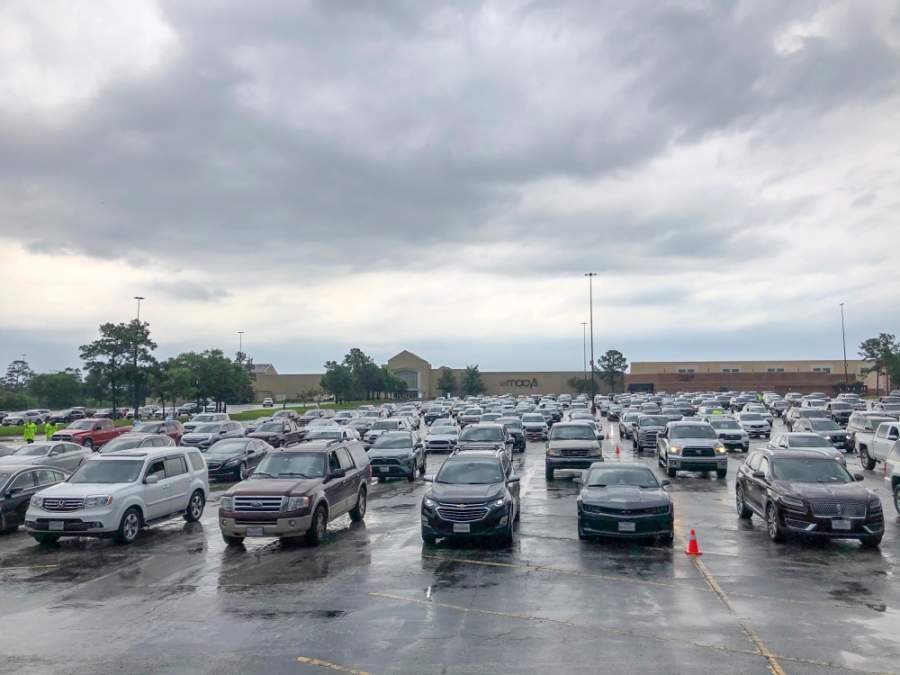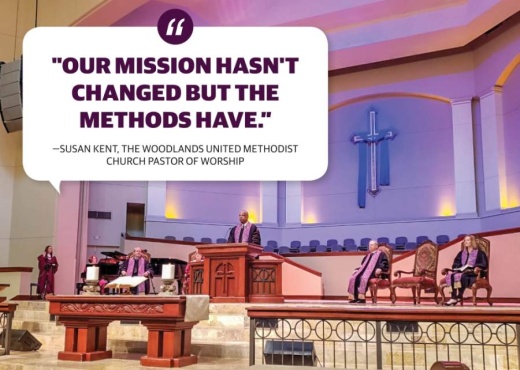Despite the changes and setbacks experienced among local faith communities, some members said the pandemic’s effects have also offered a unique chance to reflect on their work and the most essential aspects of worship and community.
“When I look back at how things have changed and the logistical aspects of it, what has been really interesting is that our mission hasn't changed but the methods have,” said Susan Kent, pastor of worship at The Woodlands United Methodist Church. “That’s been really great, to be able to see that the mission of the church stays true. No matter what the logistics are, no matter what the structure looks like, the mission has stayed the same.”
Adapting worship
As government-mandated closures halted many in-person gatherings, churches were faced with a need to offer worship services in a remote yet accessible way. For some, previous experience with online platforms allowed for a smooth transition in bringing Sunday services to the homes of congregation members and new viewers alike.
"We’re seeing a lot of our congregation sharing our services with family in other states,” Kent said. “I have been really impressed with some of the demographics that you might not assume would grasp and embrace technology."
At The Woodlands First Baptist Church, worship pastor Don Barrick said a “skeleton crew” has livestreamed regular worship services from the church sanctuary over the first weeks of online-only operations.
“We’ve had a lot of success and people being engaged with the church staff,” Barrick said. “It is kind of weird leading worship in an empty room, but our people, it’s a lot more present for them. They’re not sitting 60 feet away in the back of the worship center; they’re right there at home with their TV.”
Other digital changes include the combination of the church’s two Sunday morning services into one weekly program that appeals to the full spectrum of their congregation and the implementation of “virtual choir” performances created with individual singers’ recordings that are spliced together for Sunday broadcasts.

In an effort to bring the community together while abiding by distancing recommendations, the church also held a drive-in service at The Woodlands Mall parking lot in mid-April that allowed congregation members to gather together across parking spaces.
Sean Steele, pastor of St. Isidore Episcopal Church, said his congregation was accustomed to nontraditional worship gatherings even before the coronavirus outbreak. Members would previously gather for weekly services in places such as homes, bars or gyms. Despite seeing a rise in worship attendance, Steele said the absence of traditional gatherings has increased his members' desire for personal connections.
“There is something about gathering in a room with other people, eating together, praying together, holding hands together, looking each other in the eye and feeling that the whole is greater than the sum of its parts,” Steele said.
Maintaining communities
The closures and restrictions on worship gatherings also affected groups' ability to hold traditional holiday celebrations in April. Sts. Simon and Jude Catholic Parish's traditional Easter Mass was transitioned to an all-church video meeting that included staff leading worship and song with participation from congregation members throughout.
“We found a way ... to include families via Zoom, through virtual online video. Incorporating people in their homes where we could cut away and show families singing together, praying together,” parish communication director Jimmy Patterson said.
Mendel Blecher, rabbi at Chabad of The Woodlands, said he had to adapt his Passover plans around the same time in early April. Instead of a usual congregational gathering for the Passover Seder, Blecher said he held several online “Seder 101” classes before the holiday and packaged Seder to-go kits filled with traditional supplies, food and prayers to facilitate members’ family feasts at home.
“That was very well-received, and for the first time as a rabbi came the actual holiday itself, and I had nothing to do for my congregation, which was odd,” Blecher said. “I guess the silver lining was that I was able to empower people to conduct their own Seder.”
Worship leaders also stressed the importance that communication has provided through a time of increased isolation, especially with the loss of frequent classes and gatherings.
Patterson said Sts. Simon and Jude has maintained several Masses and Bible studies online each week in addition to establishing a daily newsletter to keep members informed on church news or provide educational materials. He said parishioners have also connected with the broader community around The Woodlands through limited charitable work and online giving.
Kent and Steele said their churches’ regular small group offerings have expanded to include new online sessions focused on members’ daily lives and the effects of isolation or depression.
“We are starting to launch groups just for processing and sharing. ... What I’ve noticed is that people really need to grief-share and joy-share and be together,” Steele said. "There’s something comforting about that that says ‘You’re not crazy, you’re not alone in this.”
Continuing connections
While members of each religious group said their community limitations due to COVID-19 restrictions are not ideal, some positives and longer-term changes may result from their experiences this spring.
While Chabad of The Woodlands canceled its services, classes, child care and musical performances this spring, Blecher said his congregation members’ time spent alone with their faith and family has filled their needs in different ways.
“It’s not going to be the same as before. Either it brings out friction, God forbid ... or it brings out more togetherness and more closeness between family members," he said. “I think it’s just making people reflect on what’s truly important in life and seeking to nurture that, or to rehabilitate those relationships.”
Steele also said the crisis has provided new opportunities for the St. Isidore community, both through the launch of its new community kitchen and the chance to improve its operations going forward.
“I think that crises are opportunities for us to make new choices, and we can waste them by just trying to get through them,” he said. “We don’t want to waste the crisis. We’re not going to waste this opportunity. This isn’t a punishment; this is a chance for us to experience who we want to be and gives us an opportunity to be something new.”
Reopening plans
Despite a strong desire to resume in-person fellowship, leaders said a return to houses of worship is likely still weeks away and will come with continued distancing requirements in place.
Barrick said the Baptist church is planning to return to in-person worship May 31 to mark the start of Pentecost. Livestreams will continue for those who wish to remain home, while in-person participants will be spaced apart and asked to wear face masks.
Sts. Simon and Jude held its first in-person Mass in early May in the church courtyard, which Patterson said was well attended with distancing measures in place. The church plans to continue offering outdoor and online weekend Masses this month while moving cautiously toward a reopening of the church for indoor programming, he said.
“We’re eager to get back but still taking into consideration the precautions that we need to continue to observe,” Patterson said.
Kent and Steele each said their churches would follow reopening guidance from their denominations’ bishops, with online-only activity continuing for both through at least the end of May. Kent said the Methodist church joined a committee of regional churches to develop best practices for reopening, while Steele said St. Isidore is following its bishop’s phased reopening plan contingent on declining local COVID-19 case counts.
Blecher said he met with dozens of Jewish leaders throughout Texas to discuss their approach to returning to worship and decided indoor spaces would remain closed through Abbott’s first statewide reopening phase ending as soon as May 18. A determination on their response to the next phase will be made this month, he said.
“Some people are itching to get back to normal, and some people will be a little bit more apprehensive or anxious about it,” he said. “I think for society and people's minds and hearts, it’s going to take time. We’re not going to snap back and everybody [says], ‘Yeah, everything’s over. Let’s go!’”





